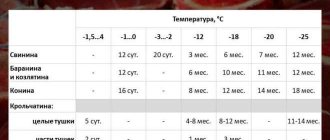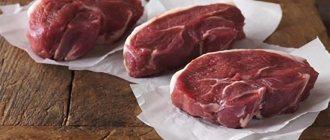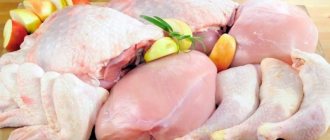Meat is a perishable product. Previously, it was purchased for future use, frozen, and processed. Today everything has changed. At any time you can go, choose, purchase a fresh cut of the desired type in the required quantity. But the need for proper storage has not disappeared. Over time, the amount of useful substances decreases, microorganisms grow and multiply, and the risk of poisoning increases. It is important to prevent this from happening.
How long meat can be stored in the refrigerator depends on its type, degree of freshness, utensils and a number of other factors. Let's look at the main methods and choose the best option.
Shelf life of fresh meat in the refrigerator
The average temperature in the refrigerator is +5°, the storage period depends on the time:
- +5° +7° – maximum 10 hours;
- 0° +5°, no more than a day;
- -4° 0°, 2 days.
The exception is minced meat and chopped products, since it is not advisable to store these products, but it is better to use them immediately after they are purchased.
| Meat | Term |
| Pork | +5 °, during the day. |
| Beef | +7 °, during the day. |
| Mutton | +4°, 48 hours. |
| Chicken | +4 °, 36 hours; +7°, 24 hours; +10°, 24 hours. |
| Goose | 12 hours at a temperature of +4°. |
| Duck | 12 hours at a temperature of +4°. |
| Rabbit | +5 °, for 12 hours. |
| Turkey | 12 hours at a temperature of +4°. |
| Ground meat | +5 °, day. |
| By-products | +4°, up to 24 hours. |
conclusions
- The current GOST does not regulate, but simply recommends the terms and conditions for storing meat. The manufacturer himself sets these parameters for his products.
- When purchasing meat products, rely on your knowledge and sense of smell. Be sure to look, touch and smell. Do not buy a questionable product.
- The refrigerator is the only suitable place to store meat products. For short-term storage, use the refrigerator, for long-term storage, use the freezer.
- Ready-made meat dishes are best consumed immediately after cooking. Storing in the refrigerator, and especially freezing, negatively affects their taste.
- Knowing the storage conditions will help you preserve, prepare and consume meat with the greatest benefit for the body.
Store correctly and be healthy!
How long does fresh meat last at room temperature?
In order to preserve fresh meat for a week, you can use traditional methods. But there is no complete guarantee of the freshness of these products. The shelf life can be affected by air humidity, high temperature, and insufficient amounts of preservatives. It all depends on where and how the meat will be stored.
| Meat | Term |
| Pork | Day. |
| Beef | Day. |
| Mutton | Day. |
| Chicken | Day. |
| Goose | Day. |
| Duck | Day. |
| Rabbit | Day. |
| Turkey | Day. |
| Ground meat | Day. |
| By-products | Day. |
Signs of meat spoilage
In a spoiled product, various processes occur with characteristic features:
- rotting - a gray, sluggish surface, an unpleasant odor indicate protein breakdown and accumulation of toxins;
- slimy film - occurs as a result of the activity of bacteria, which are activated at high air humidity and above-zero temperatures. If you transfer the product to the cold, the activity of microorganisms will decrease, but the formation of mucus will not stop;
- pigmentation - red, whitish, gray spots also appear due to the spread of bacteria and fungus;
- mold - the appearance of fungus is accompanied by a coating on the surface of the pulp.
See also
How to properly store rose hips at home, timing and choice of location
Meat spoils if the storage temperature is not maintained. External cleaning of mold, soaking meat in vinegar and marinade does not guarantee its complete safety for consumption.
Long-term storage in the freezer
To preserve any type of meat, use a freezer. The shelf life is influenced by temperature:
- down to -8°, meat products are stored for about 4 months;
- up to -12°, 8 months;
- up to -18°, 1 year.
Poultry and pieces of meat products are kept in the freezer much longer, for 12 months, chopped for 9 months, minced meat for only 4 months.
| Meat | Term |
| Pork | -18°, six months; -25°, 14 months. |
| Beef | -3°, 24 hours; -10°, 4 months; -18°, 8 months; -24°, throughout the year. |
| Mutton | -5°, 4 days; -15°, 14 days; -18°, 10 months; -25°, throughout the year. |
| Chicken | -8°, 3 months; -14°, six months; -18°, 9 months; -24°, throughout the year. |
| Goose | -12° -18°, six months. |
| Duck | -12° -18°, six months. |
| Rabbit | -12°, six months. |
| Turkey | -12° -18°, six months. |
| Ground meat | 4 months. |
| By-products | 3 months. |
SanPiN and GOST
Technologies for raising livestock are developing. The manufacturer sees it as inappropriate to send animals to pasture and fatten them for a year and a half, and therefore synthetic amino acids were introduced into the diet, which affect the growth rate and quality of meat.
GOST no longer establishes specific storage periods and conditions - it depends on the manufacturer. However, GOST regulates the recommended time, which is prohibited to exceed. Thus, the storage period of chilled beef, which was vacuum-packed at a temperature of -1...+4 ̊C and a humidity of about 85%, should not exceed 25 days from the moment of slaughter. This period includes the ripening period of the product, which is at least 5 days.
For each category of meat, as well as for beef, there are its own standards, which are regulated by GOSTs and SanPiN - they are shown in the table.
| Boneless meat products | ||||
| Large pieces: | Acceptable storage time | |||
| Packaged meat, as well as portioned semi-finished products (split; tenderloin; natural beefsteak; entrecote; rump steak; lamb, beef, pork, oven; schnitzel, escalope, etc.) without breading; | Up to two days | |||
| Portioned semi-finished products (rump steak, natural pork or lamb cutlet, schnitzel) breaded. | Up to one and a half days | |||
| Small-piece semi-finished products: | ||||
| Beef stroganoff, fried, azu, beef for stewing, meat for shish kebab, goulash, special roast, cold cuts (without sauces and spices); | Up to one and a half days | |||
| Marinated and with sauces | Until one day | |||
| Minced meat semi-finished products: | ||||
| Molded, stuffed, and also breaded (zucchini, peppers, cabbage rolls); | Up to one day | |||
| Combined: meat and vegetable cutlets, meat and cabbage cutlets, meat and potato cutlets, containing soy protein. | Until one day | |||
| Minced meat: pork, beef and other slaughtered livestock, combined: | ||||
| Made by meat processing plants; | Up to one day | |||
| Made in retail and catering establishments. | Up to 12 o'clock | |||
| Semi-finished meat and bone products (portioned, large-piece, small-piece). | Up to one and a half days | |||
| By-products of slaughtered animals (liver, tongue, kidneys, stomachs, heart, brains). | Up to one day | |||
| Semi-finished poultry meat products. | ||||
| Natural semi-finished poultry products: | ||||
| Meat-and-bone, boneless (no breading): carcass prepared for subsequent processing, hams, fillets, quarters, tobacco chickens, thighs, wings, drumsticks, breasts; | Up to two days | |||
| Meat-and-bone, boneless (breaded), with spices, with sauce, marinated. | Until one day | |||
| Semi-finished poultry meat products, minced, breaded or not. | Until 18:00 | |||
| Minced chicken. | Up to 12 o'clock | |||
| By-products, semi-finished products from by-products. | Up to one day | |||
| Sets for stews, jelly, soups. | Up to 12 o'clock | |||
| Ready-made meat products. | ||||
| Boiled meat: for cold dishes; in large pieces, cut into portions for soups and side dishes. | Until one day | |||
| Fried and stewed meats: roasted pork and beef for cold dishes; beef and pork fried in large pieces, cut into portions for soups and side dishes, stuffed meat. | Up to one and a half days | |||
| Fried minced meat dishes: steaks, cutlets, meatballs, schnitzels and others. | Up to one day | |||
| Pilaf, manti, dumplings, pancakes, belyashi, dumplings, pies. | Up to one day | |||
| Hamburger, sandwich ready, cheeseburger, pizza ready. | Until one day | |||
| Jelly meat dishes: jellied meat, jellied meat, brawn, jellied meat. | Up to 12 o'clock | |||
| Boiled meat by-products (udder, tongue, kidneys, heart, brains), fried. | Until one day | |||
| Liver and meat pates. | Up to one day | |||
| Chicken dishes. | ||||
| Smoked, smoked-baked and smoked-boiled carcasses and parts. | Up to three days | |||
| Ready-made poultry products, fried, boiled, stewed. | Up to two days | |||
| Products made from minced poultry meat, with garnish or sauces. | Up to 12 o'clock | |||
| Dumplings, poultry pies. | Until one day | |||
| Jelly products from poultry meat: jellies, brawns, jellied meats, as well as assorted meat products from slaughter animals. | Up to 12 o'clock | |||
| Poultry and offal pates | Up to one day | |||
| Boiled eggs | Up to one and a half days | |||
| Sausages from meat products of all types of poultry and slaughtered livestock. | ||||
| Boiled sausages produced in accordance with GOST: | ||||
| Highest and first category | Up to three days | |||
| Second category | Up to two days | |||
| Sausages cooked according to GOST in vapor-gas-tight films: | ||||
| Highest category, gourmet, containing preservatives | Up to 10 days | |||
| First category | Up to 8 days | |||
| Second category | Up to one week | |||
| Sausages, boiled sausages, meat loaves, produced in accordance with GOST. | Up to three days | |||
| Sausages, boiled sausages in vapor-gas-tight films. | Up to one week | |||
| Sausages, boiled wieners, sausages, sliced and vacuum packed in a modified atmosphere environment. | Up to 5 days | |||
| Boiled meat products (rolls, hams, pressed pork and beef, bacon, ham, pressed pork head meat, lamb in shape). | Up to three days | |||
| Boiled meat products, sliced and vacuum packed in a modified atmosphere environment. | Up to 5 days | |||
| Blood and liver sausages | Up to two days | |||
| Sausages, boiled sausages, sausages containing by-products. | Two days | |||
| Sausage products boiled from poultry meat (sausages, meat breads, frankfurters, rolls, ham, sausages, etc.) | ||||
| Highest category | Three days | |||
| First category | Two days | |||
| Sausage products cooked from poultry meat, vacuum packed in a modified atmosphere. | 5 days | |||
Shelf life of cooked meat in the refrigerator and at room temperature
Finished products can be stored in the refrigerator at +2° - + 6°.
| Meat | Refrigerator life | Life in the freezer | Time at room temperature |
| Boiled | 24 hours. | 72 hours. | Up to 48 hours. |
| Fried | 48 hours. | 3 months. | Up to 48 hours. |
| Baked | 48 hours. | 72 hours. | Up to 48 hours. |
| Stewed | 24 hours. | Cannot be stored. | Up to 48 hours. |
| Smoked | 120 hours. | Cannot be stored. | Within 36 hours. |
| Dried | Six months. | 1 year. | 30 days. |
| Salty | 3 months. | 6 months. | 7 days. |
| Pickled | 3 days. | 3 months. | Up to 24 hours. |
| Vacuum packed | 45 days. | Up to 6 months. | 3 days. |
Common Mistakes
Violations during storage of meat stocks:
- rinse meat before freezing;
- leave prepared dishes on the stove at room temperature;
- store canned food on the balcony at sub-zero temperatures;
- freeze leftover defrosted meat;
- keep meat and fish together.
When freezing meat, you need to put an expiration date on the packaging. Re-frozen meat products lose nutritional value and taste, as ice crystals destroy their structure. When freezing for a long time, you need to check the condition of the product. Gray spots from shrinkage may appear on the pulp - cold burns. Damaged products need to be thawed and cooked. Shrinkage occurs due to leaky packaging and evaporation of moisture. The effect is similar to chapping. Therefore, despite the stains, such meat is suitable for food.
Features of storing frozen meat
In terms of time, meat is stored longest in the freezer at a temperature of minus 18 degrees or lower. The shelf life of a meat product directly depends on the type of product and what cutting option was used. It can be a separate piece, a whole carcass, minced meat.
Large and small pieces
Large pieces of beef, lamb, and pork can last from 4 months to 1 year. The less time the product is in ice, the more it retains its qualities. Small pieces, goulash, cannot be stored in the freezer for more than 4 months. Poultry pieces no more than 8 months old.
Whole bird
The carcass of the poultry product can be stored throughout the year. The shelf life depends on the conditions in which the bird is stored and what type it is. The optimal storage period at temperatures from -12° to -15° for geese and ducks is a week. Chickens, turkeys and guinea fowl - 10 days. At a temperature of -25° for 14 months.
Individual parts of the bird
Poultry meat cut into pieces can be stored for up to 8 months.
Cooked meat
Boiled meat with broth can be stored for 48 hours, without broth for 24 hours. It can be kept frozen for no more than 2 weeks; after defrosting, the boiled product must be immediately stewed or boiled again.
When fried, the meat is wrapped in foil and stored in the refrigerator for no more than 72 hours, at a temperature of +2° - +4°. It is advisable to fry it again later.
Minced meat and offal
Since minced meat and offal can quickly spoil, it is not recommended to keep them in the refrigerator for more than 8 hours. After this time, you need to place these products in the freezer, wrapping them in foil or a plastic bag. The shelf life is 2 months.
Why do they freeze?
The meat is not completely frozen, but only the top layer. They do this to increase shelf life while maintaining quality.
Only large pieces – carcasses or half-carcasses – are frozen. This process is carried out in production. It is difficult to perform freezing at home, and it does not make any sense.
It is recommended to freeze meat when transporting short distances. This process reduces shrinkage and improves hygienic conditions during transport. Frozen carcasses at a temperature of about -2°C remain fresh for 15-20 days.
Usually only fresh meat is frozen, that is, what was received immediately after the animal was slaughtered. The modes and duration of the process vary depending on the type of product. For example, cow carcasses are frozen for 6-8 hours at -30°C. In the case of pork, the duration is increased to 10 hours.
After 35-40 days, microbes begin to multiply in the frozen product and mucus appears. It is not recommended to store meat longer than 20 days.
How to properly freeze
It is recommended to freeze the meat product very quickly, at the lowest temperatures. You need to cut the meat into small pieces in advance. To make them harden faster. In this case, taste and nutritional values are less lost. It is also not recommended to wash the meat before freezing; it is better to wipe it.
After the meat has hardened, you can dip it in cool water to form an ice crust. Thus, the crust will help keep the product juicy, no matter how long it is stored.
Raw meat without refrigeration
Sometimes situations arise when you need to save meat, but you don’t have access to a refrigerator. To extend the freshness of chilled meat for a couple of days without lowering the temperature, you can take the following measures:
- A strong solution of table salt - a large volume of the mineral dissolves in water. Moisten a cotton towel with the solution. The piece of meat is wrapped in paper and a wet towel on top of it.
- Rub the piece of meat with lemon juice or table vinegar and close it in a glass jar without a lid.
- The chilled piece of meat is wrapped in fresh nettle leaves and placed in a glass container, which is wrapped in a damp natural cloth (a cotton towel is suitable). Instead of glass containers, it is permissible to use enameled ones.
- Using chilled milk, the meat product is placed in a pan, and fresh milk is poured on top of it so that the liquid completely covers the piece.
Attention! Regardless of the method chosen, meat must be stored in a dark and cool place.
Another option to preserve meat without refrigeration is drying it. The whole piece of meat is washed well with warm water, the veins and fat are removed. Then the piece is wiped with paper napkins or towels. The recipe is as follows:
- cut the meat into cubes, approximately 1*1 cm;
- the chopped product is sprinkled with spices, chopped onions are added;
- put under oppression for one day;
- the cubes are laid out on a baking sheet in one layer, salted;
- dry in the oven at low power (up to 55 °C) for 10-12 hours.
When the dish is ready, it is dark in color and feels dry, elastic and tough to the touch.
Properly dried meat can remain usable for two months without refrigeration, provided it is kept in a tightly sealed container. Before use, this product must be boiled for 20 minutes.
It is permissible to preserve chilled meat, but it is important to follow the rules, since violating them can lead to a serious illness - botulism. Use a glass container whose volume does not exceed 1 liter. The jar is sterilized and then filled with fresh, boiled, stewed or baked meat, which is filled with sauce or water almost up to the neck, but with a distance of 2 cm from it. Close with a sterile lid. The jar is placed in water, which is brought to a boil; as the water evaporates, the liquid is added. The boiling time for the jar is one and a half hours. The next day it is advisable to repeat sterilization. If canned meat is kept at temperatures up to +10 °C, then sterilization is repeated after 3 months.
Storage of semi-finished products
Semi-finished products are divided into types:
- natural;
- chopped;
- breaded.
Natural ones are made from chilled meat product. It can be: lamb, beef, pork, chicken. Chopped are products made from minced meat, for example, meatballs, kebab, steak. Breaded semi-finished products are cutlets, zrazy, schnitzels, croquettes, which are rolled in breadcrumbs and eggs.
To preserve the taste and aroma of semi-cooked products, you need to select and set the required temperature. All semi-finished products are stored refrigerated at +6°C for up to 3 days. This applies to home-made semi-finished products or those brought from a culinary store. Those that are manufactured at the factory are stored according to their established requirements.
The lower the temperature, the longer the shelf life of the product. But do not forget that when frozen for a long time, the taste of the products disappears. Semi-finished products should be stored separately from raw meat and prepared foods.
What are the dangers of eating expired food?
Under no circumstances should you ignore the expiration date of meat. Eating expired food causes:
- staphylococcal infection;
- dysentery;
- salmonellosis;
- botulism.
The consequences of the above dangerous diseases can be very sad. Expired meat is not only very dangerous. It loses most of the beneficial amino acids under the influence of destructive putrefactive reactions. The pleasant taste of meat and aroma disappears.
How can you tell if it has gone bad? After long-term storage, the product acquires a grayish tint to the surface and an unpleasant odor. Previous
Food and dishesRules for storing fresh fish in the refrigerator
Next
Products and dishes How to preserve salted fish at home for a long time?
Proper processing of meat “with flavor”
You can process the meat product in the following way:
- Soak in table vinegar for 60 minutes. To do this, add 1 tbsp per liter of water. vinegar.
- Prepare a saline solution, add 2 tbsp per liter of water. sea or table salt. Soak the pulp in it for 3 hours.
- Soak the pulp in a weak solution of potassium permanganate for 60 minutes, then rinse under water and leave for 15 minutes in a cup of cool water.
- Add 2 tbsp to the chamomile decoction. sugar and immerse the pulp in it for 20 minutes.
- Pour red wine, season with rosemary, thyme, leave for 1 hour.
- Coat the tenderloin with mustard, put it in a cool place for 2 hours, and rinse under the tap.
- Spread the tenderloin with aromatic seasonings and leave for an hour.
- Coarsely chop the onion and garlic and combine with herbs. Marinate the pulp for 2 hours.
- Saturate the pulp with soy sauce, wine, and aromatic spices. Leave in the marinade for 2 hours.
What happens to the product over time
Immediately after the slaughter of an animal, processes begin to occur in the muscle tissues, due to which the taste, smell, color, juiciness and consistency change. During the first 3 hours the product is gentle and has great moisture-holding capacity. Gradually this indicator worsens, the meat becomes dry and tough.
With further aging under certain conditions, the product acquires tenderness and aroma. Meat juice begins to stand out from it.
When stored in a home refrigerator, meat gradually loses moisture. Because of this, the rate of oxidative processes increases. Bacteria begin to multiply quickly. This leads to bad odor and mucus. At this stage the product should not be consumed.
The last stage of spoilage is rotting. This is the breakdown of proteins, which is caused by the activity of putrefactive microorganisms. They get into meat during primary processing at the slaughterhouse, improper storage, transportation and various violations of sanitary standards.
Ways to increase shelf life
If it is not possible to keep meat in the refrigerator or freezer, follow these steps:
- moisten the cloth in a solution of salicylic acid;
- wrap the product in this cloth;
- The freshness of the meat product is maintained for 10 hours.
You can also preserve the original appearance of meat in other ways:
- Wet a towel or any cloth in a strong salt solution and wrap the product and the bag in it. This can be stored for 3 days.
- Cover the meat product with nettles and place in an enamel or glass container. Wrap with a wet cloth. Use this method for 2, 3 days.
- Rub with vinegar or sour juice and place in an enamel bowl. No need to cover. The method is effective for 2 days.
- A fresh piece should be washed and placed in chilled milk, preferably homemade, for 3 days.
How to tell if meat has gone bad
The main sign of spoilage is smell. It appears in any product, be it sausage, soup, fried chicken or minced meat. Unscrupulous sellers use various tricks to disguise the aroma. If you buy meat in a store, there is no need to rush to the checkout. It’s worth walking around for a bit with the bag tied, and then opening it and sniffing it.
Storing meat in the refrigerator
Other signs:
- cloudy juice Fresh meat, when pressed or cut, releases a clear, pinkish liquid;
- slippery surface, slime . Ideally, the cut is slightly damp and does not stick when touched;
- gray, yellow spots . There is no uniform color. All shades of pink and red are allowed;
- yellow, gray, greenish fat . Beef and goat meat from an old animal have a creamy tint. Ideally, the layers are white, milky in color;
- a hole remains . Fresh meat, when pressed with a finger, is quickly restored.
If the meat has just started to disappear, an unpleasant odor will appear during cooking. For example, when cooking soup or stewing.
Most often, producers send the missing meat to be marinated for barbecue. Vinegar and onions cover up the smell well. Buying such products is dangerous to your health.
How to determine the freshness of a product
Before deciding how to preserve meat, you need to choose and purchase the right product. Its quality depends on packaging, type and pre-processing. The shelf life of boiled meat is much shorter than that of raw or smoked meat. How to determine the freshness of a product in order to know its starting state.
- The product is identified by color. It should be uniform, without additional inclusions. If beef is red, then lamb is darker, pork is pink, rabbit and poultry are pale pink.
- The smell of a fresh product is slightly perceptible; it should not contain any acidic or musty scents.
- Fatty varieties are easy to check for quality. Marble veining is a privilege of a high-quality product. The fat on fresh meat is white and does not have a tint of yellow unless this characteristic is a distinctive feature of the species.
- When you press a high-quality piece with your finger, the dent immediately smoothes out, as it springs. A stale product loses its shape and becomes loose in consistency.
An indicator of low-quality meat is the presence of mucus or mold, a gray tint and an unpleasant odor. A fresh product without freezing may already acquire some of the signs of spoilage by the evening.
Signs of a spoiled product
To understand that the dish is spoiled:
- change in appearance;
- foreign unpleasant odor;
- the appearance of mold;
- sour or bitter taste.
Even if there are no obvious signs that the dish is spoiled, it is still not recommended to eat it after 7 days.
In any preparation of dishes, you should adhere to the principle - it is better to cook less, but more often, than to cook a lot for the week ahead. Long-term storage can lead to indigestion and poisoning. If you discover that the product has begun to deteriorate, throw it away immediately; you should not put your body in danger. Your health is the most important thing you have.
Marking according to GOST
According to current regulations, meat products are allowed to be consumed only with a veterinary stamp. And also with accompanying documentation confirming the veterinary inspection.
It is strictly forbidden to accept meat with only one veterinary certificate and no mark.
The marking represents complete information about this product and may contain signs, inscriptions, drawings, symbols and other designations. Labeling is applied to consumer packaging in accordance with current standards (Article 4, clause 4.1 of the technical regulations TR CU 022/2011). Consumer labeling of meat products must contain:
- Name of the product type.
- Product composition.
- Quantity of goods presented.
- Date of manufacture of meat products.
- Best before date.
- Storage conditions for the semi-finished product (with closed and opened packaging). They are installed in accordance with GOST R-51074-2003 and the rules of the Customs Union.
- Location, name of the manufacturer and his contacts.
- Recommendations for use or existing restrictions on preparation.
- Nutritional value indicators.
- Information about additional ingredients included in the composition (GMOs, dyes, preservatives).
Table
| Type of meat | Best before date |
| chilled | 1-7 days |
| fresh | 1-3 days |
| frozen | 4-12 months |
| smoked | 7-10 days |
| boiled | 1-7 days |
| pickled | 4-10 days |
| in a vacuum | 3-7 days |
Read about how to properly store churchkhela here.










